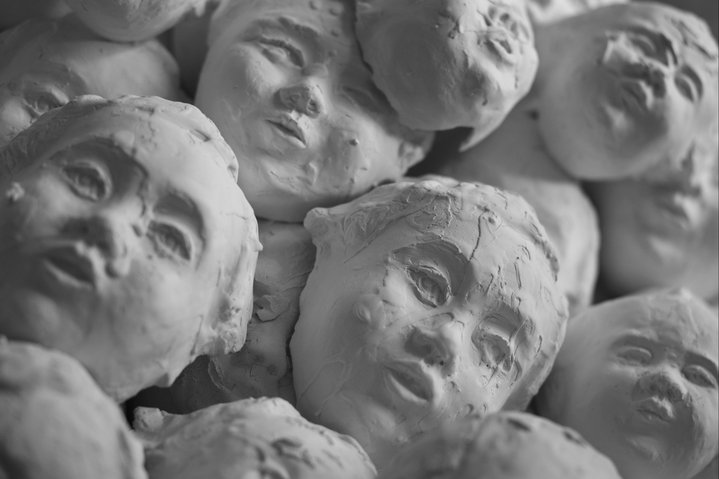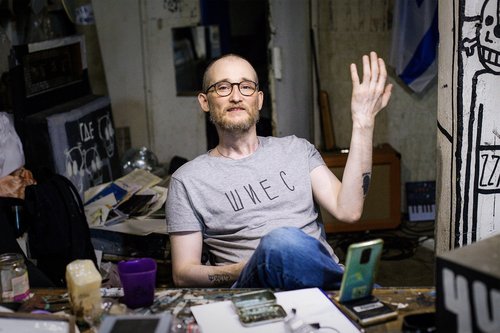Posthumous Exhibition in Moscow Celebrates the Art of Valery Chtak

This Is Not Everything, But It’s a Lot. Exhibition view. Moscow, 2025. Courtesy of Syntax Gallery
The retrospective organised by Moscow’s Syntax Gallery, pays homage to the late Valery Chtak (1981–2024). It presents the astonishing breadth of an artist who remained intensely productive throughout his life, bringing together the diverse techniques, periods, and themes that defined his practice – while leaving visitors to puzzle, inevitably in vain, over the hidden meanings behind his cryptic, multilingual messages. As he moved through the exhibition, art critic and curator Sergey Guskov found himself reliving flashes of the many equally enigmatic conversations he once had with the artist.
The retrospective of Valery Chtak (1981–2024), ‘This Is Not Everything, But It’s a Lot’, which is currently on view at Cube.Moscow, organised by Syntax Gallery, is relatively modest in scale – especially considering the sheer volume of the artist’s legacy. Chtak was exceptionally prolific, even in his final years, when he faced both financial difficulties and serious illness. Yet this exhibition, which brings together around seventy works, is remarkably representative: it traces the key phases of his artistic development and captures the wide range of techniques and themes that preoccupied him. Curators Elvira Tarnogradskaya and Irina Gorlova have genuinely sought to present Chtak in all his breadth.
Here one finds the famous ‘In My Case Under No Circumstances’ or “Smrt je smrt”, and, in fragments, his trick alphabet with masterpieces like ‘G – Trees’ or ‘Sh – Fence’, and works created shortly before his death, late pieces like the self-portrait with the inscription “Wit Against Illness”. The exhibition comprises paintings and works on paper as well as furniture and kitchen utensils painted by the artist including objects from various projects, ranging from the 2007 ‘Layerism’ exhibition at the Cheremushki apartment gallery to the IV Moscow Biennale in 2011.
In all his interviews – and there were many, given how talkative Chtak was – he steadfastly refused to offer any explanatory framework for his work. He joked, cursed, clowning his way through conversations; he hurled paradoxes, leapt from subject to subject, and overwhelmed listeners with comparisons to other artists that he would promptly contradict. In short, he expertly disoriented his interlocutors. Often, within the same breath, he could respond to a leading question with “Yes, that’s right,” only to add immediately, “But on the other hand, it’s all completely different.” At times he proposed three or four different interpretations of his own method, only to chuckle and dismantle each one as the conversation continued. His stance seemed to say: understand it any way you like.
Chtak was often irritated when people looked for deep meanings in his work. The epidemic of hyper-interpretation that struck the art world in the late 2000s and persisted until the end of the 2010s was very unsympathetic to Chtak – and he did not hide his antipathy towards this awful trend. However, at the same time, the artist continued to write words and entire phrases on canvas, paper, cardboard or furniture in numerous languages, including some very rare ones totally incomprehensible to most people, not to mention the use of puns, reduplication, and other philological games. Combined with his somewhat emblematic visual vocabulary, these “texts” seemed deliberately designed to provoke viewers into solving charades and searching for hidden meanings. Chtak was like someone dropping a banknote on the street whilst watching from
Chtak found it amusing when people approached his work with suspicion, unable to deal with the urge to search for meanings, and tried to decipher works in which, by and large, nothing was encrypted. And if this desire to find meaning was particularly zealous, the artist would get angry. Sometimes he would literally say: “Open your eyes!” Rude, but fair. Everything that exists is already present on the surface of the work. Beneath this interface there may be painted-over layers, and there was certainly one material or another at the base, but there were no hidden narratives or ideas. Throughout his artistic practice, Chtak insisted on one principle to see the thing itself, not the thoughts or conjectures people would project onto it.
Overall, the verbal component in Chtak’s work tended to work against the possibility of any subtext or broader context – let alone a “grand narrative.” His abundance of hints and allusions led nowhere and only deepened the sense of confusion. Moreover, he could craft a pseudo-proverb or an ersatz everyday utterance so deftly that viewers would exclaim, “That’s life, we hear this all the time,” even though, in reality, none of them had ever encountered anything like it before; every phrase was entirely his invention. Chtak deliberately thwarted any attempt to construct a coherent system of signs from his work. In his world, absurdity held sway, and constant shifts, mutations, and acts of language-creation unfolded – reckless, exuberant, and utterly unrestrained.
At the same time, he always remained extremely sensitive to the material dimension of art. Though not without mockery, Chtak always described what he was doing with utmost precision. For example, in one conversation with me back in 2011, he expressed himself as follows: “From the outside it probably looks like this: a bloke makes grey-black-and-white paintings, a bit smaller, a bit bigger, on the floor, on the ceiling, clean, dirty, but, in principle, all the same.” It is worth noting: the deliberate choice of the perspective of an external observer speaking about himself in the third person also served as a strategy for avoiding exact meaning-making – similar to what you saw in his work. Or about cardboard: unlike those artists who saw an expression of political position in this unstable material, and a conscious approach to cultural production, like Thomas Hirschhorn (b. 1957) insisted, Chtak would declare it was just easy to paint on cardboard on the floor and then hang it on the wall.
This kind of rationality – which, thanks to Chtak’s scathing public remarks, was often mistakenly taken for cynicism – combined with his drive for practical realisation, rollicking absurdism, and relentless resistance to home-grown critical hermeneutics, both anticipated and, in several cases, directly inspired the art that emerged in the second half of the 2010s. Sadly, as his health declined, he could no longer fully participate in these developments and spent more time working quietly in his studio. Yet whenever he mounted an exhibition, he delivered with full force. What else can one say about the PGT project (2022) at the Fabrika Centre for Creative Industries, where the show had to be viewed from a balcony and seemed to enact a return to the very origins of his practice – primitivism, self-styled Dadaism, and a wholehearted “come what may” spirit. Even in difficult times, he never stopped savouring life and playing the hooligan; in the case of such an irrepressible absurdist, it could hardly have been otherwise.




















